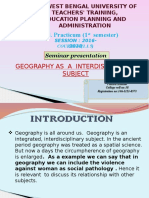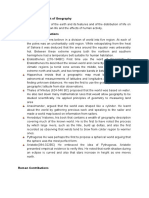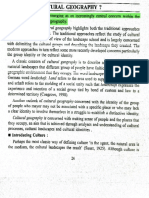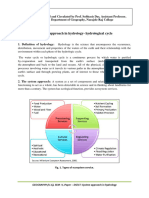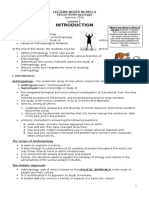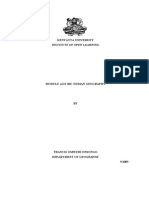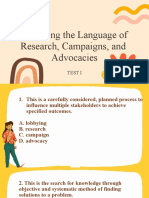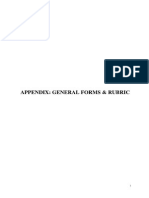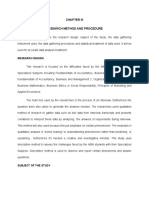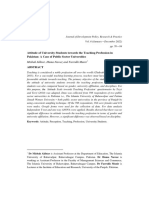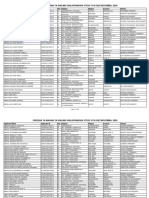Professional Documents
Culture Documents
Evolution of Geographical Thought
Evolution of Geographical Thought
Uploaded by
Kamini 1788Original Description:
Original Title
Copyright
Available Formats
Share this document
Did you find this document useful?
Is this content inappropriate?
Report this DocumentCopyright:
Available Formats
Evolution of Geographical Thought
Evolution of Geographical Thought
Uploaded by
Kamini 1788Copyright:
Available Formats
lOMoARcPSD|6054646
Evolution OF Geographical Thought
Geography (University of Delhi)
StuDocu is not sponsored or endorsed by any college or university
Downloaded by 88 kamini Sharma ([email protected])
lOMoARcPSD|6054646
EVOLUTION OF GEOGRAPHICAL THOUGHT
ASSIGNMENT 2
SUBMITTED BY – SOMYA BHATIA
18 /GEO/038
SUBMITTED TO – Mr. Balakrishnan P.
QUESTION - Write a detailed essay on how have the
historical events/episodes influenced the development of
geographical thinking?
Introduction –
What is Geography? Geography is the study of places and the relationships between people and
their environments. Geographers explore both the physical properties of Earth’s surface and the
human societies spread across it. They also examine how human culture interacts with the natural
environment, and the way that locations and places can have an impact on people. Geography
seeks to understand where things are found, why they are there, and how they develop and
change over time.
History of Geography: The history of geography is closely connected with the history of human
society and its development. It is part of human interests, and precedents can be found in all
ancient cultures. But as a science, geography is relatively young and many of its fundamentals
appear during the nineteenth century.
Downloaded by 88 kamini Sharma ([email protected])
lOMoARcPSD|6054646
The first geographical references are from travelers describing the landscapes and the people
living in them, the first scientific studies are from mathematicians and physicists interested in the
environment. It can thus be said that the foundations of geography are in the natural sciences,
from the need to explain the physical environment and also on the idea of the influence of this
environment on humans and society.
Livingstone asserts that for generations, geography has been intimately involved in exploration,
at least since the time of Muslim scholar-travelers, the voyages of the Scandinavians, Chinese,
and medieval Christian adventurers. But it was with the European voyages of reconnaissance,
during the fifteenth and sixteenth centuries, that this first-hand knowledge of the world
contributed most decisively to coherent body of geographical knowledge of the terrestrial globe.
The significance of scientific travel was mainly due to Alexander von Humboldt through his
explorations in South America.
The knowledge explosion occasioned by the European voyages of exploration brought new
cartographic challenges and accomplishments. Although around the Mediterranean, Portolano
Sea charts had been circulating for a long time and there already existed various Mappaemundi,
the new lands discovered had to be reduced to paper. Gerard Mercator solved some of the
mathematical problems associated with transferring a sphere to a flat surface with his famous
map projection. In the following centuries, geography's close links with cartography continued to
be maintained. The map, as both graphic language and visual representation, continues to be used
as a geographical tool, at present with the invaluable assistance of remote sensing and
Geographical Information Systems.
The first work entitled Geography was written in Alexandria, in the third century B.C., by
Eratosthenes. From those beginnings the study of the earth as the home of humans, of earth
processes, and of the distribution of terrestrial phenomena has continued to our day. Writings
range from biblical texts and early Greek explanations to the first formal statements on
geography as a science, written between 1650 and 1850.
EARLY GEOGRAPHERS -
1. Chinese
Kish presents several Chinese geographical writings taken from the work by Needham and Wang
Ling, Science and Civilization in China. The section dedicated to earth sciences includes
examples of early Chinese geographical writing. The oldest Chinese geographical document is
The Tribute of Yü, written during the 5th century B.C. and considered the first naturalist
document in Chinese history. It is a survey of several provinces of China, including their soils,
agricultural products and great rivers. Needham and Wang Ling believe it may be contemporary
with the work of the Ionian geographer-philosophers. Other Chinese geographical documents are
Downloaded by 88 kamini Sharma ([email protected])
lOMoARcPSD|6054646
descriptions of southern regions and foreign countries, written during the first millennium of the
Christian era. A much later book (fourteenth century) deals with Chinese trade with lands around
the Indian Ocean and beyond. A Chinese pilgrim, Hsüan-Chang, wrote on Indian cosmography
and on the lands and peoples of southern Asia during the 7th century A.D. Fa'Hsien, 5th century
A.D., describes his pilgrimage travels. It has to be borne in mind that to Buddhist a travel to
India is similar to the Muslims pilgrimage to Mecca. Chau Ju-Kua dealt with Chinese overseas
trade and maritime expeditions of the 13th century, a book of the typo of a geographical
encyclopedia
2. Greek and Latin
The principles of geographical writing were formulated in the days of Greek and Hellenistic
science. Homer’s Iliad and Odyssey (9th century B. C.) are often considered to be the first
geographical works, in the sense that they provide detailed descriptions of the people and places
visited. For Kish, Hesiod's poems represent the earliest written traditions of our Greek heritage.
Hesiod (8th century B.C.) wrote about the yearly cycle in the life of Greek country folk. Works
and Days has been called a shepherd's calendar, and describes the march of the seasons and the
associated environmental changes. In the poem Theogony, he describes the power of the winds
over the lives of men. Holt-Jensen explains how scholarly Greek writers produced topographical
descriptions of places in the known world, discussing both natural conditions and the way of life
of the people living there. Herodotus (485-425 BC), although considered the father of history,
described geographical events in a geographical setting, and some of his writings are truly
geographical in character. He not only described geographical phenomena as, for example, the
annual flow of the Nile, but also attempted to explain them. In addition, he incorporated older
sources of geographical information, including the existing maps. In this way Herodotus used
earlier theories and descriptions which would otherwise have been forgotten.
The writings of the Latin encyclopedists were based on the work of their Greek predecessors.
During the late Empire and through much of the Middle Ages, the Latinspeaking West, unable to
read the original sources, relied entirely upon these Roman authors of handbooks. Vano, Pliny,
Pomponius Mela, Solinus, and Macrobius were read, copied, and later still, printed-while
Aristotle, Hipparchus, and Strabo were only names in a long list of authorities quoted in
geographical writings. Holt-Jensen explains how the topographical tradition of Greek geography
was carried forward into Roman times. Strabo and Ptolemy can be considered to have had the
most direct influence on the future shape of European geography. Strabo (64 BC—AD 20) wrote
a work of 17 volumes called Geographica. This was largely an encyclopedic description of the
known world whose chief value was that it preserved for posterity many writings that he
annotated and cited. Geographica also included attempts to explain cultural distinctiveness, types
of governments and customs in particular places. The significance of natural conditions for
Downloaded by 88 kamini Sharma ([email protected])
lOMoARcPSD|6054646
cultural development was discussed in relation to a number of places, especially in the
description of Italy.
3. Muslim Geography
While accomplishing the pilgrimage to Mecca, Moslems traveled across much of the Old World
relying on written geographical information and often adding greatly to it. The Moslem
contribution to geography took many forms. Possibly the most important was the translation and
absorption of knowledge from various sources, mainly from Greeks. The preservation of these
writings was essential later on for the revival of geography in the Christian world. A second
contribution was the compilation of geographical descriptions of the world of Islam, which
extended from the Atlantic to the Pacific. Muslims also made original contributions in
mathematical geography and surveying. With the rise and spread of Islam (7th to 14th century
A.D.), Muslim geographic knowledge increased considerably as a result of travel for religious
and economic reasons. Geography has always been a special interest to Muslims as many
religious rituals such as fasting and prayer required the appropriate knowledge of time and
direction. This sense of time and direction encouraged an early stage the development of relevant
instruments for measurements. One of the earliest observatory stations was established by the
Arabs in Damascus, Baghdad and Cairo. During the Middle Ages the Muslims had more
advanced culture than did most of medieval Europe, specially in Al-Andalus. They had made
great discoveries in various fields and, above all, preserved many of the writings of ancient
Greek, Roman and other oriental civilizations. Learned men with knowledge of Arabic and
Hebrew translated into Latin many manuscripts. The centers of learning in Muslim Spain were
thriving, with scholars from many places and particularly so from Europe. Spain became the land
of contact between Islam and Christianity. As Arabic was the language of culture and learning,
many books were translated from Arabic into Latin and other European languages including
German, French and English. It is worth mentioning that during the X century there was an
important school of translators in Ripoll Monastery, in the Catalan Pyrenees near the French
border. Gerbert d’Orlhac, who became Pope Sylvester II (999-1003), obtained in Ripoll his
scientific background that he later introduced in Europe.
4. Christian Geography
The earliest contribution of Christian geography was, like that of Muslim contributions, the
production of guidebooks for pilgrims, in this case traveling to the Holy Land. This can be
exemplified by the Bordeaux Itinerary and by Bishop Eucherius' Epitome . . .about certain holy
places. A second type of Christian geography is based entirely on scripture, as in the case
Christian Topography by Cosmas. The third genre was the encyclopedia, a form already well
established in Roman times, being the best example the Etymologiae by Isidore of Seville. It is to
the Byzantines that we owe the survival of Ptolemy's work, but few examples of actual
Byzantine geographical writing exist. One is that of Procopius, a historian of the age of Justinian
Downloaded by 88 kamini Sharma ([email protected])
lOMoARcPSD|6054646
and the second that of Constantine VII, an emperor-statesman who ruled the Byzantine Empire
during the tenth century.
The writings of these navigators produced a great deal of geographical information. Columbus
describes the first glimpse of the West Indies in his Journal (1451-1506) preserved by the
Spanish historian Las Casas, and on his formal report to Ferdinand and Isabelle. The letter is the
oldest authentic document of the European presence in the New World. He writes of high
mountains, broad sketches of country, forests and extremely fruitful fields excellently adapted for
sowing and grazing, building dwelling houses, excellent harbors, and a wealth of rivers. He also
mentions differences between islands. He also describes the inhabitants, their appearance and
way of living. The best maps showing the results of discoveries were drawn, engraved, and
published in Italy. But the credit for reforming geography, for giving up-at least in part- the
exclusive reliance on classical and biblical authorities, and for introducing personal observation
belongs to the German humanists.
Some people have trouble understanding the complete scope of the discipline of geography
because, unlike most other disciplines, geography is not defined by one particular topic. Instead,
geography is concerned with many different topics—people, culture, politics, settlements, plants,
landforms, and much more.
What distinguishes geography is that it approaches the study of diverse topics in a particular way
(that is, from a particular perspective). Geography asks spatial questions—how and why things
are distributed or arranged in particular ways on Earth’s surface. It looks at these different
distributions and arrangements at many different scales. It also asks questions about how the
interaction of different human and natural activities on Earth’s surface shape the characteristics
of the world in which we live.
Because the study of geography is so broad, the discipline is typically divided into specialties. At
the broadest level, geography is divided into physical geography, human geography, geographic
techniques, and regional geography. Thus , Geographical perceptions can be traced from very
ancient cultures, although geography as all sciences developed during the Enlightenment, but it
was in the early nineteen century when it was firmly established based in many aspects in the
Darwinian revolution.
Downloaded by 88 kamini Sharma ([email protected])
You might also like
- The Foundations Chinese Medicine Comprehensive PDFDocument4 pagesThe Foundations Chinese Medicine Comprehensive PDFKlinik Asysyifa13% (24)
- Module 1. Places and LandscapesDocument32 pagesModule 1. Places and LandscapesEdsel Buletin100% (2)
- WEEK 5-6 Landscapes of Secondary Activities Industrial RevolutionDocument10 pagesWEEK 5-6 Landscapes of Secondary Activities Industrial RevolutionJerlyn Mae Quiliope-Lumamba100% (1)
- Geography As A Inter Diciplinary SubjctDocument12 pagesGeography As A Inter Diciplinary SubjctBarunMondal100% (2)
- Meaning Scope of Environment GeographyDocument15 pagesMeaning Scope of Environment GeographyAzeez AdegbiteNo ratings yet
- Introductory Module For GeographyDocument6 pagesIntroductory Module For GeographyJeffreynald Arante FranciscoNo ratings yet
- Activity 1. Multiple-Choice Questions. (1 Point For Each Number)Document2 pagesActivity 1. Multiple-Choice Questions. (1 Point For Each Number)Norienne TeodoroNo ratings yet
- UNIT 1 - Lesson 1Document10 pagesUNIT 1 - Lesson 1Dianne Mae LlantoNo ratings yet
- Political Geography NotesDocument28 pagesPolitical Geography NotesMohaiminul Islam Bappy100% (1)
- Human Geography PDFDocument6 pagesHuman Geography PDFDaliya Chakroborty50% (2)
- Historical Background of Social Science.Document2 pagesHistorical Background of Social Science.FaulknerMascardo100% (1)
- Asian Studies Midterm QuestionnaireDocument3 pagesAsian Studies Midterm QuestionnaireLea Rovie Daria Mascardo0% (1)
- SST 101 I. History of Geography HGDocument10 pagesSST 101 I. History of Geography HGJomar CatacutanNo ratings yet
- Concept of Space in GeographyDocument10 pagesConcept of Space in GeographySourav Karjee100% (5)
- Development of GeographyDocument17 pagesDevelopment of GeographyUdara Seneviratne100% (7)
- Historical Development of GeographyDocument1 pageHistorical Development of GeographyJerome Alvarez0% (1)
- Environmental GeographyDocument33 pagesEnvironmental GeographyMahamudul Hasan100% (1)
- Evolution of Geography: Greeks, Romans, Muslims and European ContributionDocument39 pagesEvolution of Geography: Greeks, Romans, Muslims and European ContributionGernatology AgNo ratings yet
- Environment Geography PDFDocument145 pagesEnvironment Geography PDFRahul SinghNo ratings yet
- Contribution of American Geographers in Geography and RadicalismDocument8 pagesContribution of American Geographers in Geography and Radicalismchristine sNo ratings yet
- Different Approaches in Urban GeographyDocument4 pagesDifferent Approaches in Urban Geographysamim akhtarNo ratings yet
- Environmental HistoryDocument10 pagesEnvironmental HistoryShreya Rakshit0% (1)
- History of Geographical ThoughtDocument25 pagesHistory of Geographical Thoughtfuturejns100% (3)
- Basic Concepts in GeographyDocument4 pagesBasic Concepts in GeographyAnna Louise Wy100% (1)
- 1 - Geography and Its BranchesDocument28 pages1 - Geography and Its BranchesJan Alam100% (2)
- Foundation of Social Studies (SSED-113)Document23 pagesFoundation of Social Studies (SSED-113)Via OctosoNo ratings yet
- Urban GeographyDocument117 pagesUrban Geographymartin sirifave100% (1)
- Evolution of Geographical Thought 6th Sem (H) CC13T 15 04 2020Document24 pagesEvolution of Geographical Thought 6th Sem (H) CC13T 15 04 2020Pankaj PharswanNo ratings yet
- Nature Scope and Content of Cultural Geography and Cultural DevelopmentDocument7 pagesNature Scope and Content of Cultural Geography and Cultural DevelopmentKaushiki KunduNo ratings yet
- Places and Landscape 3 FINALDocument11 pagesPlaces and Landscape 3 FINALRomar M. DavidNo ratings yet
- Development and Importance of Population Geography.Document16 pagesDevelopment and Importance of Population Geography.zumar shah100% (4)
- Evolution of GeographyDocument8 pagesEvolution of GeographyLysander Garcia0% (1)
- Study Guide For Module No. 1Document6 pagesStudy Guide For Module No. 1Maia GabrielaNo ratings yet
- Determinism and Possibilism in GeographyDocument6 pagesDeterminism and Possibilism in GeographyRaghu Kushwaha100% (1)
- Course Outline in Philippine Geography (2011)Document3 pagesCourse Outline in Philippine Geography (2011)jetzon202286% (7)
- Global Trigger FactorsDocument3 pagesGlobal Trigger Factorsaubrey viernes100% (1)
- Introduction To GeographyDocument88 pagesIntroduction To GeographyRommel Laurenciano100% (1)
- Dualism in GeographyDocument11 pagesDualism in GeographyKamini 1788100% (1)
- Systems Approach in Hydrology-Hydrological CycleDocument4 pagesSystems Approach in Hydrology-Hydrological CyclePankaj Chowdhury100% (1)
- Lecture Notes in Ssci 4 (Socio-Anthropology) : Lesson 1Document5 pagesLecture Notes in Ssci 4 (Socio-Anthropology) : Lesson 1Deanne Mitzi SomolloNo ratings yet
- Name: - Score: - Asian Studies I. MULTIPLE CHOICE: Blacken The Circle That Corresponds To The Letter of The Best AnswerDocument5 pagesName: - Score: - Asian Studies I. MULTIPLE CHOICE: Blacken The Circle That Corresponds To The Letter of The Best AnswerMicahCastro100% (1)
- Course Outline On Places and LandscapesDocument12 pagesCourse Outline On Places and LandscapesMicheleNo ratings yet
- Dualism and Dichotomy in Geography: Geography With Sandeep SirDocument6 pagesDualism and Dichotomy in Geography: Geography With Sandeep SirSarveshVishnar100% (3)
- All Paradigms-Geographical-Thought.....Document11 pagesAll Paradigms-Geographical-Thought.....Kamini 1788100% (4)
- BA III Neo-Determinism - DR Vinita PrasadDocument8 pagesBA III Neo-Determinism - DR Vinita Prasadkarthick reddyNo ratings yet
- What Is GeographyDocument3 pagesWhat Is GeographyFrenzie Mae Vasquez RiveraNo ratings yet
- Humanistic Approach in GeographyDocument8 pagesHumanistic Approach in GeographySarveshVishnarNo ratings yet
- Scope of GeomorphologyDocument4 pagesScope of GeomorphologyArshdeep Singh100% (3)
- Asian Studies ReviewerDocument31 pagesAsian Studies ReviewerNika De VeraNo ratings yet
- SSE 101foundation of Social StudiesDocument2 pagesSSE 101foundation of Social StudiesEdwin SamisNo ratings yet
- Prelim Exam, Pame Marvin Teaching ApproachDocument4 pagesPrelim Exam, Pame Marvin Teaching ApproachMarvinbautistaNo ratings yet
- Kinds of Threats in NatureDocument4 pagesKinds of Threats in NatureMa. Cristina CancinoNo ratings yet
- Social Studies and Other DisciplineDocument20 pagesSocial Studies and Other DisciplineHAZIEL EMBESTRO0% (1)
- Human Geo NotesDocument86 pagesHuman Geo NotesHenry NdunguNo ratings yet
- Geography: History of Geographic StudyDocument2 pagesGeography: History of Geographic StudyBryan Jhonson BathanNo ratings yet
- Towards Relevant Education For All: 1. Explain The Diversity and Spatial Differentiation in The CityDocument2 pagesTowards Relevant Education For All: 1. Explain The Diversity and Spatial Differentiation in The CityJun Mark Balasico YaboNo ratings yet
- Module 2 in Foundation of Social StudiesDocument17 pagesModule 2 in Foundation of Social StudiesRomar M. DavidNo ratings yet
- MODULEDocument17 pagesMODULErose dela cruzNo ratings yet
- Historical Development of GeographyDocument24 pagesHistorical Development of GeographyAtul Sharma33% (9)
- Historical Development of Social Studies in Different Key NationsDocument8 pagesHistorical Development of Social Studies in Different Key NationsRaquisa Joy LinagaNo ratings yet
- Unesco - Eolss Sample Chapters: Main Stages of Development of GeographyDocument10 pagesUnesco - Eolss Sample Chapters: Main Stages of Development of GeographySifat ullah shah pakhtoonNo ratings yet
- Unit 1-3 EducationDocument158 pagesUnit 1-3 EducationKamini 1788No ratings yet
- Contribution of Arab Geographers in Geography of The WorldDocument9 pagesContribution of Arab Geographers in Geography of The WorldKamini 1788No ratings yet
- Quantitative-Revolution Quantitative-Revolution: Geography (University of Delhi) Geography (University of Delhi)Document16 pagesQuantitative-Revolution Quantitative-Revolution: Geography (University of Delhi) Geography (University of Delhi)Kamini 1788No ratings yet
- Social Inclusion MeasuresDocument5 pagesSocial Inclusion MeasuresKamini 1788No ratings yet
- All Paradigms-Geographical-Thought.....Document11 pagesAll Paradigms-Geographical-Thought.....Kamini 1788100% (4)
- Dualism in GeographyDocument11 pagesDualism in GeographyKamini 1788100% (1)
- CET22Document40 pagesCET22binodeNo ratings yet
- English 10 - ReviewDocument31 pagesEnglish 10 - ReviewLlemor Soled SeyerNo ratings yet
- Anna University ResultDocument1 pageAnna University ResultFooty Arena ChelseaNo ratings yet
- UntitledDocument157 pagesUntitledOwusu Ansah BrightNo ratings yet
- Fast Publication JournalsDocument10 pagesFast Publication Journalsrikaseo rikaNo ratings yet
- Dissertation/Project Guidelines 2021-22 (20MBA6402) : Dayananda Sagar University, BengaluruDocument16 pagesDissertation/Project Guidelines 2021-22 (20MBA6402) : Dayananda Sagar University, BengaluruPawar ComputerNo ratings yet
- 2022-2023 C LEVEL 1st TERM L&S PACINGDocument7 pages2022-2023 C LEVEL 1st TERM L&S PACINGEmre AltundalNo ratings yet
- Unit WeightDocument6 pagesUnit WeightEnas S RadaidehNo ratings yet
- Ucchatar Madhyamik Star Ke Vidhyarthiyon Ke Parivarik Vatavaran Shaikshik Uplabdhi Env Aatm Pratyay Ka AdhyayanDocument5 pagesUcchatar Madhyamik Star Ke Vidhyarthiyon Ke Parivarik Vatavaran Shaikshik Uplabdhi Env Aatm Pratyay Ka AdhyayanAnonymous CwJeBCAXpNo ratings yet
- Constructivism As A Theory For Teaching and LearningDocument6 pagesConstructivism As A Theory For Teaching and LearningYonael TesfayeNo ratings yet
- FYP1 & FYP2 Forms With Rubrics 2014 v2.1Document33 pagesFYP1 & FYP2 Forms With Rubrics 2014 v2.1redz00No ratings yet
- Subject of The StudyDocument3 pagesSubject of The StudyJanna GunioNo ratings yet
- MathsDocument18 pagesMathsRange0% (1)
- Influence of Aesthetics Attributes of Brand Web Pages On Customer Brand EngagementDocument22 pagesInfluence of Aesthetics Attributes of Brand Web Pages On Customer Brand EngagementNOOR AKMA AIDANo ratings yet
- ODDocument438 pagesODKavitha RagupathyNo ratings yet
- The Nature and Elements of Poetry (1892)Document380 pagesThe Nature and Elements of Poetry (1892)Carl D'Souza67% (3)
- Prediction of Air Quality Index Using Supervised Machine LearningDocument14 pagesPrediction of Air Quality Index Using Supervised Machine LearningIJRASETPublicationsNo ratings yet
- Rupert J. Ederer, SolidarismDocument10 pagesRupert J. Ederer, Solidarismmullen65No ratings yet
- Practical Reseach 1 Module 5Document22 pagesPractical Reseach 1 Module 5Edel Bryan BardinasNo ratings yet
- A08 - Rubrik Panel PSM 1Document5 pagesA08 - Rubrik Panel PSM 1anuarmNo ratings yet
- Attitude of University Students Towards The Teaching Profession in Pakistan: A Case of Public Sector UniversitiesDocument15 pagesAttitude of University Students Towards The Teaching Profession in Pakistan: A Case of Public Sector UniversitiesJournal of Development Policy, Research & PracticeNo ratings yet
- Majina Ya Walimu PDFDocument197 pagesMajina Ya Walimu PDFKennedy KamwelaNo ratings yet
- Letter of MotivationDocument1 pageLetter of MotivationSaad AhmedNo ratings yet
- 1-Socio-Intro-Jamai (Compatibility Mode)Document28 pages1-Socio-Intro-Jamai (Compatibility Mode)Salah-Eddine HafedNo ratings yet
- TSPSC Group 1 Prelims ScheduleDocument4 pagesTSPSC Group 1 Prelims ScheduleKrishna BatturuNo ratings yet
- Understanding TechnologiesDocument8 pagesUnderstanding TechnologiesArjay BajetaNo ratings yet
- Reducing The Efficiency Gap by Optimal Allocation Using Modified Assignment Problem For Apparel Industry in Sri LankaDocument1 pageReducing The Efficiency Gap by Optimal Allocation Using Modified Assignment Problem For Apparel Industry in Sri LankaShivam BhandariNo ratings yet
- Practical Research 1 ReviewerDocument9 pagesPractical Research 1 ReviewerFaith Perl Nilo100% (1)
- Chapter 3 Phil HistoryDocument24 pagesChapter 3 Phil HistoryYsabelleeeeeNo ratings yet



